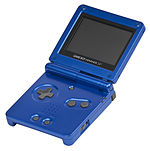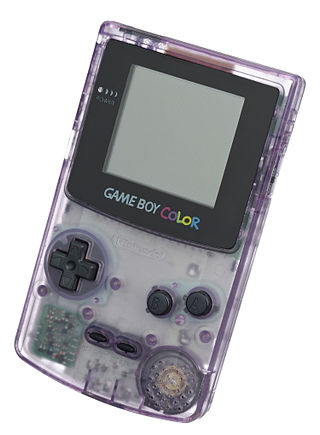
The Game Boy Color is an 8-bit handheld game console, manufactured by Nintendo, which was released in Japan on October 21, 1998, and to international markets that November. It is the successor to the Game Boy and part of its product line. Compared to the original, the Game Boy Color features a color TFT screen rather than monochrome, a processor that operates twice as fast, and four times as much memory. It retains backward compatibility with games initially developed for its predecessor. However, reviewers considered these improvements insufficient to justify Nintendo's releasing it as a separate product.

A handheld game console, or simply handheld console, is a small, portable self-contained video game console with a built-in screen, game controls and speakers. Handheld game consoles are smaller than home video game consoles and contain the console, screen, speakers, and controls in one unit, allowing players to carry them and play them at any time or place.

Mario Kart: Super Circuit is a 2001 kart racing game for the Game Boy Advance (GBA). It is the third Mario Kart game and retains its predecessors' gameplay: as a Mario franchise character, the player races opponents around tracks based on locales from the Super Mario platform games. Tracks contain obstacles and power-ups that respectively hamper and aid the player's progress. Super Circuit includes various single-player and multiplayer game modes, including a Grand Prix racing mode and a last man standing battle mode.

The Game Boy Advance SP, released in Japan on February 14, 2003, is a sixth-generation handheld game console developed, released, and marketed by Nintendo that served as an upgraded version of the original Game Boy Advance. The "SP" in the name stands for "Special". It is the penultimate console in the Game Boy Advance product line before the Game Boy Micro, which was released in September 2005.

The Nintendo e-Reader, commonly abbreviated as e-Reader, is an add-on manufactured by Nintendo for its Game Boy Advance handheld video game console. It was released in Japan in December 2001, with a North American release following in September 2002. It has an LED scanner that reads "e-Reader cards", paper cards with specially encoded data printed on them.

The Game Boy Player is a GameCube peripheral developed by Nintendo which enables it to play Game Boy, Game Boy Color, and Game Boy Advance cartridges, allowing those games to be played on a television.
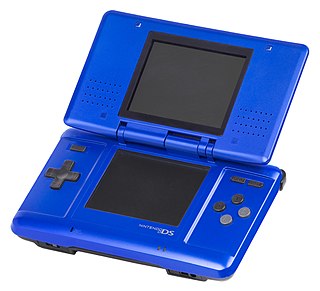
The Nintendo DS is a foldable handheld game console produced by Nintendo, released globally across 2004 and 2005. The DS, an initialism for "Developers' System" or "Dual Screen", introduced distinctive new features to handheld games: two LCD screens working in tandem, a built-in microphone and support for wireless connectivity. Both screens are encompassed within a clamshell design similar to the Game Boy Advance SP. The Nintendo DS also features the ability for multiple DS consoles to directly interact with each other over Wi-Fi within a short range without the need to connect to an existing wireless network. Alternatively, they could interact online using the now-defunct Nintendo Wi-Fi Connection service. Its main competitor was Sony's PlayStation Portable during the seventh generation of video game consoles.

Sonic Advance, known as SonicN on the N-Gage, is a 2001 platform game developed by Dimps and published by Sega for the Game Boy Advance. It was the first Sonic the Hedgehog game released on a Nintendo console with Sonic Adventure 2: Battle on the GameCube, and was produced in commemoration of the series' tenth anniversary. The story follows Sonic, Tails, Knuckles, and Amy as they journey to stop Doctor Eggman from taking over the world. Controlling a character, players are tasked with completing each level, defeating Eggman and his robot army, and collecting the seven Chaos Emeralds.
In the history of video games, the sixth generation era is the era of computer and video games, video game consoles, and handheld gaming devices available at the turn of the 21st century, starting on November 27, 1998. Platforms in the sixth generation include consoles from four companies: the Sega Dreamcast (DC), Sony PlayStation 2 (PS2), Nintendo GameCube (GC), and Microsoft Xbox. This era began on November 27, 1998, with the Japanese release of the Dreamcast, which was joined by the PlayStation 2 on March 4, 2000, the GameCube on September 14, 2001 and the Xbox on November 15, 2001, respectively. On March 31, 2001, the Dreamcast was among the first to be discontinued. Xbox in 2006, GameCube in 2007 and PlayStation 2 was the last, in January 2013. Meanwhile, the seventh generation of consoles started on November 22, 2005, with the launch of the Xbox 360.
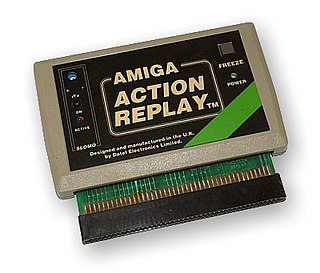
Action Replay is the brand name of a cheating device created by Datel. The Action Replay is available for many gaming systems including the Nintendo DS, Nintendo DSi, Nintendo 3DS, PlayStation Portable, PlayStation 2, GameCube, Game Boy Advance, and the Xbox. The name is derived from the first devices’ signature ability to pause the execution of the software and save the computer's state to disk or tape for future “replay”. The ability to manipulate the contents of memory in this paused state permitted the cheat functions for which the brand is now better known.

The Transfer Pak is a removable accessory for the Nintendo 64 controller that fits into its expansion port. When connected, it allows for the transfer of data between supported Nintendo 64 (N64) games and Game Boy or Game Boy Color (GBC) games inserted into its cartridge slot. By using the Transfer Pak, players can unlock additional content in compatible games; the Pokémon Stadium games, with which the Transfer Pak was initially bundled for sale, also feature the ability to emulate specific Game Boy Pokémon titles for play on the N64.

The GameCube Game Boy Advance cable (DOL-011) is a video game accessory manufactured by Nintendo which is used to connect the Game Boy Advance (GBA) handheld console to the GameCube (GCN) home console. Depending on the games it is used with, the cable may facilitate transferring data between related games, unlocking additional content, or turning the GBA into a controller or second screen.
Game Boy Advance Video is a format for putting full color, full-motion videos onto Game Boy Advance ROM cartridges. These videos are playable using the Game Boy Advance system's screen and sound hardware. They were all published by Majesco Entertainment, except for the Pokémon Game Boy Advance Video cartridges, which were published by Nintendo. Most cartridges were developed by DC Studios, Inc., except for the few labelled "Movie Pak" which were developed by 4Kids Entertainment's subsidiary 4Kids Technology, Inc. The video cartridges are colored white for easy identification and are sold as Game Boy Advance Video Paks; these offer the same 240×160 resolution as standard Game Boy Advance games, except for the Shrek and Shark Tale pack, which is at 112p.

The Game Boy Micro is a handheld game console developed and manufactured by Nintendo. It was first released in Japan on September 13, 2005 as a smaller, lighter redesign of the Game Boy Advance. The system is the last Game Boy handheld, alongside the AGS-101 model of the Game Boy Advance SP. Unlike its predecessors, the Game Boy Micro lacks backward compatibility for original Game Boy and Game Boy Color games.

The Game Boy Advance Wireless Adapter is a wireless adapter accessory for the Game Boy Advance, released by Nintendo in 2004. It provides an alternative to the Game Boy Advance Game Link Cable but is only supported by a small number of games. The Game Boy Advance Wireless Adapter is also compatible with the Game Boy Advance SP, Game Boy Player, and e-Reader.

The Nintendo Game Link Cable is an accessory for the Game Boy line of handheld video game systems, allowing players to connect Game Boys of all types for multiplayer gaming. Depending on the games, a Game Link Cable can be used to link two games of the same title, like Tetris, or two compatible games like Pokémon Red and Blue. Games can be linked for head-to-head competition, cooperative play, trading items, unlocking hidden features, etc.
This is a list of video game accessories that have been released for the Game Boy handheld console and its successors. Accessories add functionality that the console would otherwise not have.

The Japanese multinational consumer electronics company Nintendo has developed seven home video game consoles and multiple portable consoles for use with external media, as well as dedicated consoles and other hardware for their consoles. As of September 30, 2021, in addition to Nintendo Switch, Nintendo has sold over 863.07 million hardware units.
GameCube accessories include first-party releases from Nintendo, and third-party devices, since the GameCube's launch in 2001.
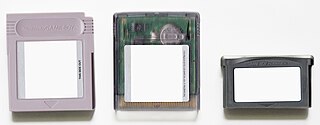
Game Boy Game Pak is the brand name of the ROM cartridges used to store video game data for the Game Boy family of handheld video game consoles, part of Nintendo's line of Game Pak cartridges. Early Game Boy games were limited to 32 kilobytes (KB) of read-only memory (ROM) storage due to the system's 8-bit architecture. Nintendo later incorporated a memory bank controller into cartridges to allow for more storage by switching between ROM banks. This change allowed Game Paks to reach 8 megabytes (MB) of storage, allowing for more complex games.






